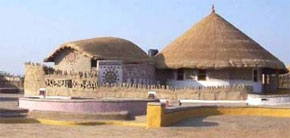Indians believe in holidays: The country has among the largest number of public holidays in the world. Yet the most common reason for getting away is to “visit a native place.” Migrant workers return to their family farms at harvest time. Others return to their villages (and extended families) for an annual pilgrimage. The concept of a holiday where you let your hair down and relax has been accepted only in recent years.
The idea of rural tourism is, therefore, a bit of a puzzle for many Indians. They go back to their village every year; why should they pay good money to go to some other village? Rustic charms hold greater appeal for foreign tourists. Concerted government and travel industry efforts to sell India abroad with campaigns such as “Incredible India” began only this decade, but rural tourism as a product is still evolving.
A national tourism policy was introduced in 2002, with rural tourism identified as a focus area to generate employment and promote sustainable livelihoods. “As a part of the National Tourism Policy 2002, the Ministry of Tourism is developing and promoting rural tourism sites which have core competency in art, craft, culture, heritage, handloom, etc.,” Union Ministry of Tourism Secretary Sujit Banerjee said recently in a statement. According to the 2002 policy, “Special thrust should be imparted to rural tourism and tourism in small settlements, where sizable assets of our culture and natural wealth exist.”
Just what is rural tourism? The government has taken a broad view. “Any form of tourism that showcases rural life, art, culture and heritage at rural locations, thereby benefiting the local community economically and socially as well as enabling interaction between the tourists and the locals for a more enriching tourism experience, can be termed as rural tourism,” says a Ministry of Tourism policy paper. “Rural tourism is essentially an activity which takes place in the countryside. It is multifaceted and may entail farm/agricultural tourism, cultural tourism, nature tourism, adventure tourism and ecotourism. As against conventional tourism, rural tourism has certain typical characteristics: It is experience-oriented; the locations are sparsely populated; it is predominantly in natural environments; it meshes with seasonality and local events; and it is based on the preservation of culture, heritage and traditions.”
Not everyone applies such a broad definition. Ecotourism — which concerns itself with the preservation of the environment while offering the best to tourists — is more fashionable these days. And some in government and the tourism industry would like to focus on ecotourism rather than rural tourism, which could have a down-market, rough-it-out connotation. “Ecotourism and rural tourism are not exactly the same but can be clubbed together for greater benefits,” says Md. Jawaid, a former minister in the eastern state of Bihar who has promoted the website ecotourismindia.com. “This is just an information site now,” Jawaid says. “It is a small effort on my part to promote tourism in the rural areas of India. But we have big plans. The potential is huge.”
Rajesh K. Aithal, assistant professor of marketing at the Indian Institute of Management, Lucknow, has another definition. “Rural tourism is a form of tourism in which the guests get to enjoy the unique culture of village life through participation in events, or experiencing the local cuisine, or buying ethnic goods, and in the process also improve the welfare of the local people.”
Two Types of Tourism
Mandip Singh Soin, president of the Ecotourism Society of India, a group of tourism professionals and environmentalists formed with the Ministry of Tourism’s backing, says the concept can be confusing. “Rural tourism is understood differently in different parts of the world,” he notes. “Ecotourism and rural tourism are the same only in a sense. They are cousins really. Rural tourism may not necessarily be the protector and enhancer of conservation. It is much more community-oriented. Ecotourism is more holistic; all responsible tourism actions come into play.”
The difference is best illuminated by a couple of examples. As part of its 2002 plan, the government partnered with the United Nations Development Program (UNDP) for an Endogenous Tourism Project. Some 30 rural sites were selected in 20 states to develop as destinations for rural tourists. The UNDP pumped in an initial US$2.5 million. The government asked the states and union territories to submit proposals. Those that were selected were entitled to assistance up to US$100,000.
One of the project’s success stories is Hodka village in Gujarat. A village tourism committee owns and operates the Shaam-e-Sarhad (“Sunset at the Border”) Village Resort. The accommodations are simple. Tourists can stay in tents or traditional mud huts, known as bhungas. All have attached bathrooms, Western toilets and showers. The resort can accommodate up to 30 people. Staying in tents costs around US$40 a night, while the bhungas are more expensive, around US$60 a night. Among the attractions: specially organized workshops in embroidery and leather work; interactions with other artisan communities; wildlife including flamingos, pelicans, foxes and leopards; and nearby archaeological sites of the Indus Valley Civilization. In January 2008, there was even a pashu mela — a cattle fair. All this activity has had to be organized, packaged and sold.
Far away from Hodka, in the northeastern state of Meghalaya, is Mawlynnong. Neither the UNDP nor the government of India has been involved with this ecotourism effort’s success. Rather, a community effort has made it the poster child of rural tourism in India. In 2003, Discover India (a magazine published by Media Transasia along with the Union Ministry of Tourism) anointed it the cleanest village in Asia. It has retained its charms. “Mawlynnong’s reputation for cleanliness has even earned it a place on the state’s tourism map,” according to a report by the BBC. “Hundreds of visitors from all over India now visit the village throughout the year.” Mawlynnong also attracts tourists from around the world.
Both Mawlynnong and Hodka demonstrate a key prerequisite for the success of any rural tourism project: community involvement. “Going by our experience in setting up community-owned companies in the rural sector, the outcome depends on a number of factors, and host communities should be encouraged to play a pivotal role in the development of rural tourism,” says William Bissell, managing director of Fabindia and author of the recently published Making India Work. Fabindia is a novel experiment in which rural artisans — the suppliers to this private retail platform — are shareholders in the company. (See “The Poor as Stakeholders: Can ‘Inclusive Capitalism’ Thrive in India?”)
Community Involvement
The point about community involvement is also made by Mott MacDonald, a global management, engineering and development consultancy that the Ministry of Tourism asked to evaluate the rural tourism scheme. Its report, submitted in June 2007 after five years of operation, says: “In order to make the scheme more meaningful, it is very important that the sustenance issues be discussed with the community before the start of the project.” Fear of the unknown once was common, but it has disappeared in the projects undertaken. “Xenophobia has been removed from the minds of the local people,” the report notes.
Before the Ministry of Tourism became involved, this fear of foreigners was just one of the basic issues that hindered the flow of tourists to the sites chosen by the government and the UNDP. From the start, the sites had the advantages of historical importance, craft, culture, cuisine and natural beauty. But hindrances included a lack of basic infrastructure including sanitation, drinking water and wayside amenities; a lack of accommodation and food facilities; and a lack of awareness about site importance and the need for local guides.
Most of the issues have been addressed. “With the intervention of the Ministry of Tourism, there has been considerable change,” the Mott MacDonald report notes. “The rural tourism scheme has been a valuable vehicle to bring the ultimate rural stakeholders in touch with the tourism sector to increase employment.” The report continues: “Rural tourism is not the end, but the means to stimulate economic growth, to increase the viability of underdeveloped locations, and to improve the living standards of local populations.” Adds Bissell of Fabindia: “With proper training and the infrastructure in place, rural tourism certainly has the potential to generate large-scale employment. What we need is commitment and a long-term view.”
“The development of a strong platform around the concept of rural tourism is definitely useful for a country like India, where almost 74% of the population resides in its seven million villages,” the Ministry of Tourism’s policy paper notes.
A Nod to the Bottom Line
Yet increasing the bottom line for tourism is equally important. After all, there is a limit to the number of tourists you can pack into the Taj Mahal and Khajuraho. Today, with exports plummeting amid the global economic slowdown, tourism has become a key foreign-exchange earner. According to Ministry of Tourism figures, foreign-exchange earnings from tourism in 2008 were around US$11 billion, an increase of 14.4% from 2007. A total of 5.37 million tourists visited India in 2008, an increase of 5.6% from 2007. But in the first nine months of 2009, foreign tourist arrivals were down 7.7% from the same period a year earlier. Earnings will also be down, though those numbers are not yet available.
The government is doing all it can to boost these figures. In October, at a Dubai road show for its Visit India 2009 tourism campaign, Pronab Sarkar, secretary of the Indian Association of Tour Operators (IATO), unveiled some highlights for foreign tourists. Among them: an IATO-sponsored complimentary one-day rural eco-holiday in the country.
Tour operators are businessmen. Would they be bothered about the larger picture of rural employment and sustainability? Yes, says Soin of the Ecotourism Society. The society was set up last year because “we feel we needed to have our tourism sector do the right thing in terms of responsible tourism actions that would allow for a smaller tourism footprint ecologically. At the same time, we wanted to look at how tourism can get its dollars to flow down the supply chain more equitably and involve the local communities to be partners in tourism operations. We also want to be the watchdog of tourism in the country.”
Soin responds to criticism that rural tourism exploits poor people in the villages and damages the environment. “This is not correct,” he says. “Most revenues are being earned and kept at the village level so it goes into the pockets of the villagers either as direct individual earnings or collective cooperative efforts. In fact, in areas like [the northeastern state of] Nagaland, where the ecology was being damaged by village lads hunting rare pheasants, the trend got reversed when they saw the opportunity for earning money as guides showing these pheasants to bird watchers.” Adds Aithal of IIM: “A well-executed rural tourism project has the potential of becoming a win-win proposition both for the tourist and the villagers.”
There is a lot of potential for rural tourism in India, Aithal notes. “‘Rural’ as an entity is fast disappearing, especially in the developed world. Even for young urban Indians, rural would be something that they would want to connect to.” Adds Jawaid of ecotourismindia.com: “Both Indians and foreigners can be targeted.” For the moment, however, it’s the foreign tourist who is being wooed. “Initially, the target will be foreigners as this is a novelty for them,” Soin says. “It may not be that novel an experience for Indians. Indians demand more comfort in lodging and are less prone to roughing it out.”
“Rural tourism is in its nascent stage in India,” Aithal notes. “But it will grow. There is a huge market out there. The experience of many countries shows that rural tourism can be seen as an alternate source of livelihood and employment. The main problems with rural tourism are the same as with any rural development project. Can you scale up these projects? Can you replicate them? And how do you make these projects stand on their own without money being pumped in from outside? For this you need very strong village-level institutions, which can take up the execution once the project has been initiated.”
According to Fabindia’s Bissell, “If sites are selected with care, on the basis of potential and core competency, and the project implementation focuses as much on the ‘software’ aspects of human development along with the ‘hardware’ of capacity building and infrastructure development, there is every reason to anticipate a positive outcome. As a multi-sectoral activity, using multiple services provided by a range of suppliers, rural tourism is an area where a strong public-private partnership is of prime importance, particularly given the number of ministries beyond tourism — for example, rural development, culture, environment and tribal welfare — that could be involved.”



